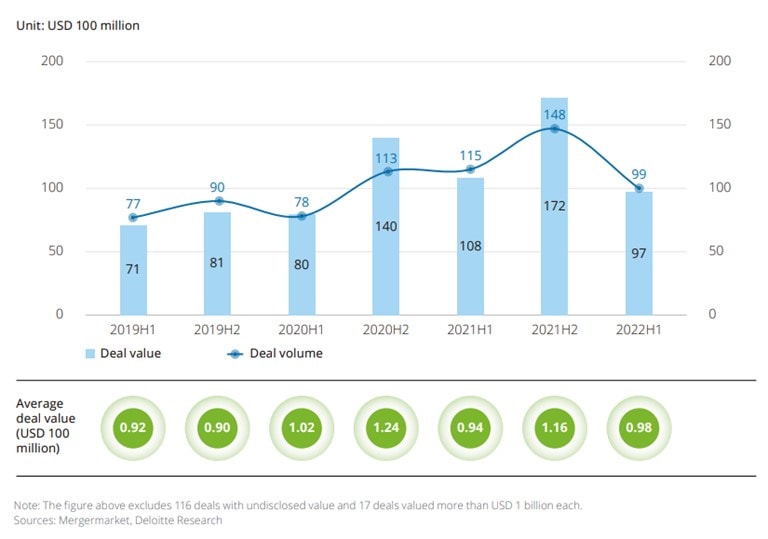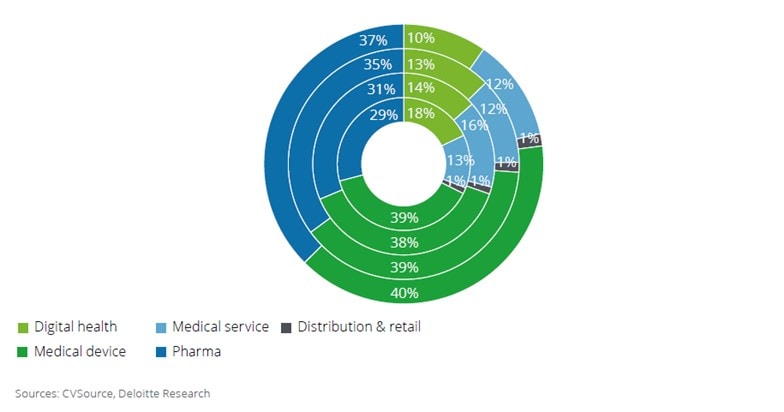Press releases

Biopharma continues to grow from strength to strength
2023 China LSHC Investment and M&A Market Outlook
Published: 14 December 2022
- Sentiment, valuations, and market activity in China's life sciences and healthcare sector were robust in 2021 before declining in 1H 2022
- Biotech and pharmaceutical M&A volume in 1H 2022 amounted to 73 deals, maintaining at the same level as 1H 2021
- Driven by trends including Healthy China 2030, the sector remains on track for strong growth over the coming years
The 2023 China LSHC Investment and M&A Market Outlook, released at the BIOHK2022 convention, takes a deep dive into the trajectory and trends of M&A and investment and financing activity in China's life sciences and healthcare (LSHC) sector over the past two years.
Overall, according to the Market Outlook, sentiment, valuations, and market activity were strong at the start of 2021, following the introduction of COVID-19 vaccines at the turn of the year and optimism that the pandemic would abate. In 2H 2021, however, the sector began to correct amid COVID-19 restrictions in China and emerging fiscal policy, economic, and geopolitical concerns globally, with this correction lasting until around the end of 2022.
However, as the world emerges fully from the pandemic, prospects for China's LSHC sector are strong, driven by megatrends such as Healthy China 2030.
"In recent years, biotechnology has become a hot topic in LSHC," says Professor Albert Yu, Chair of the Hong Kong Biotechnology Organization. The continuous improvement of Hong Kong's technological strength cannot be separated from the support of its motherland. It must fully integrate into the development of the Guangdong-Hong Kong-Macao Greater Bay Area and not only rely on its own capital to enter biotechnology's global stage. BIOHK2022 is a door to Hong Kong's biotechnology sector as part of its mission to become an international innovation and technology center."
M&A: Biotech and pharmaceutical deals dominate as TCM gains traction
According to the 2023 China LSHC Investment and M&A Market Outlook, M&A activity in China's LSHC sector picked up in 2021, with 262 transactions1 – 71 more than in 2020. Transaction value increased by 27.9% year-on-year to USD28 billion, and there were 108 transactions of more than USD100 million, more than half of these in biotech and pharmaceuticals. M&A activity then eased off in 1H 2022, with 99 deals, down from 115 in 1H 2021.
Figure 1 — M&A Transactions in the LSHC Industry (2019 -2022 H1)

That said, some segments outperformed, with Traditional Chinese Medicine (TCM) seeing seven deals in 1H 2022 – equalling with the whole of 2021 – driven by supportive policies focused on innovative development and equal emphasis being put on TCM and Chinese and Western medicine, and the biotech and pharmaceutical segment particularly strong with M&A volume already equaling those in 2021.
Within overall LSHC M&A, there were 33 outbound and 27 inbound deals in 2021. In 1H 2022, outbound activity held up, but inbound activity declined notably. Licensing deals followed a similar trajectory to overall M&A, with license-in hovering at around 80 deals in 2H 2020, 1H 2021, and 2H 2021 before dropping to 64 in 1H 2022 and further to just 26 deals in 2H 2022 so far.
The industry will continue to upgrade by boosting original innovation and increasing foreign investment, which will be characterized by two major trends: an innovative, coordinated development model for domestic and foreign capital and accelerated localization of foreign-invested companies.
Investment and financing: Digital healthcare megadeals stand out
Investment and financing followed a similar trajectory to that of M&A in China's LSHC sector in 2021 and 1H 2022. 2021 saw 1,805 investment and financing transactions, including megadeals worth USD1 billion or more, up 33% from 2020's level. Transaction value excluding the megadeals reached USD27.2 billion, up 62.9%.
The pharmaceutical and medical device segments were dominant, with 1,333 transactions or 73.9% of the total. Digital healthcare, meanwhile, had two standout megadeals, a USD3 billion Round E by a medical consultation and medication management platform and a USD2 billion Round C by a medical payment information services provider.
Figure 2 — Analysis of Fundraising Deals Volume by Segment in the LSHC Industry (2019, 2020, 2021 and H1 2022, from the inside out)

Several renowned PE/VC firms have become more deeply involved in China's LSHC sector of late, with three major players dominating the landscape as they took part in a combined 195 transactions in 2021, although they have tended to stay on the sidelines since. Some major tech platforms have also been active, particularly in internet medical care.
The appetite for outbound transactions among Chinese companies, meanwhile, is generally strong, with involvement in 263 such transactions since 2019, mainly in the US (67%) and with a preference for the pharmaceuticals segment (58.3% of transactions in 1H 2022). Inbound investment followed a similar pattern, with pharmaceuticals and medical equipment the most popular segments.
What the future holds
According to the 2023 China LSHC Investment and M&A Market Outlook, the sector's emerging trends are more capital flowing into private general hospitals, with increased deployments in second- and third-tier cities, and specialist hospitals in areas like medical cosmetology, dental treatment, assisted reproduction, and pediatrics, which have seen rapid growth due to their standardized operating models, high service replicability, and regional expansion.
The industry will continue to upgrade by boosting original innovation and increasing foreign investment, which will be characterized by two major trends: an innovative, coordinated development model for domestic and foreign capital and accelerated localization of foreign-invested companies.
Figure 3 — The different strategic cooperation models of multinational and local pharmaceutical Companies

"M&A and investment and financing in China's LSHC sector is expected to grow steadily over the next few years," adds Kenneth Law, Deloitte China LSHC Financial Advisory Partner. "This will be driven by policy support including LSHC's status as a key industry to be developed during the 14th Five-Year Plan period and the Healthy China 2030 initiative.
Deloitte expects development to center on continuous progress in people-centric pharmaceutical and medical development towards full healthcare coverage. Other key trends to look out for are more cooperation between local and overseas pharmaceutical companies, innovative and high-quality development of TCM, accelerated localization of high-end products by overseas medical equipment companies, and rapid growth in demand for consumer medical services.
While some industries have struggled through the pandemic, the global biotech sector has grown from strength to strength. Capital market activity in the life sciences and healthcare industry will gradually recover in the post-COVID era as the pandemic stabilizes and related control measures are relaxed.
Gladys Fung, Deloitte China LSHC Southern Region Leader says, "Being a mature financial center, Hong Kong has a key role to play for biotech fund raising and is helped by its proximity to the mainland, where biotechnology is booming. Deloitte is delighted to be one of the BIOHK2022 sponsors, as BIOHK is a great platform to connect biotech experts around the world to formulate biotech advancement and make an impact that matters to our future."
Note:
1 Except where stated otherwise, certain figures in this press release and the 2023 China LSHC Investment and M&A Market Outlook exclude deals where the value was not disclosed or was more than USD1 billion.
Recommendations
Deloitte Consulting and Allergan Aesthetics
China: Medical Aesthetic Industry Outlook 2022

